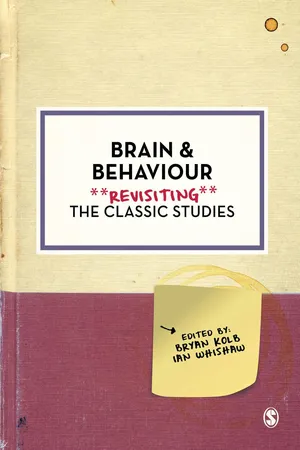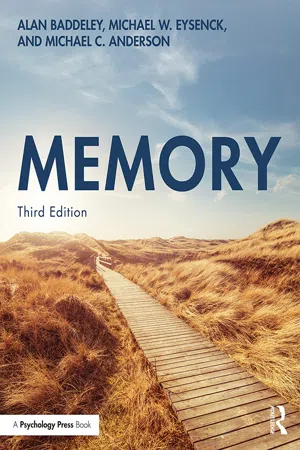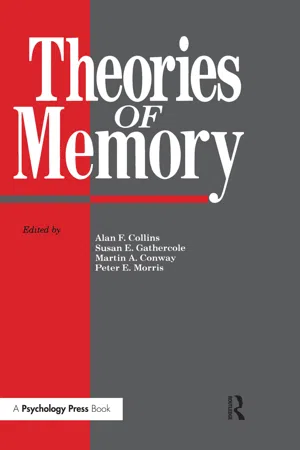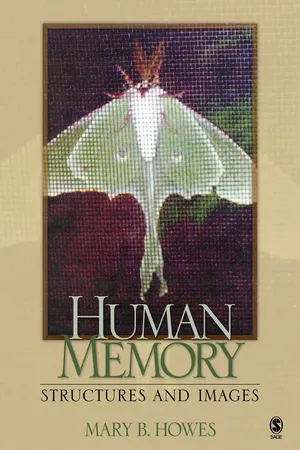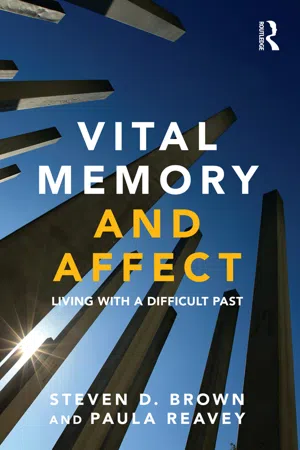Psychology
Tulving's Gold Memory Study
Tulving's Gold Memory Study, conducted by Endel Tulving in 1983, aimed to investigate episodic memory. Participants were asked to recall words they had previously studied, some of which were designated as "gold" items. The study found that participants were better at recalling the context in which they had encountered the gold items, supporting the idea of a separate episodic memory system.
Written by Perlego with AI-assistance
Related key terms
Related key terms
1 of 4
Related key terms
1 of 3
6 Key excerpts on "Tulving's Gold Memory Study"
- eBook - ePub
Brain and Behaviour
Revisiting the Classic Studies
- Bryan Kolb, Ian Whishaw, Bryan Kolb, Ian Whishaw(Authors)
- 2016(Publication Date)
- SAGE Publications Ltd(Publisher)
At the time of Tulving et al.’s case study, the impact that K.C. would have in addressing central issues in the field of memory research was not fully appreciated. For example, at that time, the consensual view of retrograde amnesia was that all declarative memories are temporally graded, with older memories surviving hippocampal damage. Tulving et al.’s observations of K.C. challenged this idea, but it was many years later that the implications of these observations for understanding key memory processes were recognized.As the full range of research inspired by Tulving et al.’s paper is beyond the scope of this chapter (see the review by Rosenbaum et al., 2005, 2014), we will focus on the impact of this ground-breaking paper on research into multiple memory systems, memory consolidation theory, and the role of the MTL in spatial memory, autobiographical memory, recognition, and future imagining.Multiple Memory Systems: Episodic and Semantic Memory
In 1972, Tulving made the insightful observation that conscious declarative memory incorporates two distinctly different types of memory: the recollection and re-experiencing of contextually-defined personal events (episodic memory, i.e. recalling your visit to the Statue of Liberty), and memory for knowledge about the world and general facts (semantic memory, i.e. knowing that the Statue of Liberty is located in New York). Along with advancing our understanding of non-declarative (e.g. procedural) memory, Tulving’s observation reinforced the principle of multiple memory systems that was beginning to receive wide acceptance. Against this background, Tulving et al.’s objective, in their initial investigation of K.C., was to explore the possibility of dissociating different types of memory in an individual whose damaged brain prevented the expression of normal memory processes. Examination of K.C.’s retrograde memory was particularly informative. Initially, it appeared that K.C. exhibited a temporally-graded retrograde amnesia - eBook - ePub
- Alan J. Parkin(Author)
- 2014(Publication Date)
- Psychology Press(Publisher)
In his initial formulation he distinguished between episodic and semantic memory. Episodic memory represented our memory for discrete personal events such as what we had for breakfast, while semantic memory was concerned with language and our general knowledge about the world, e.g. that grass is green. Tulving’s distinction was important because it showed that memory research had been principally directed towards the investigation of episodic memory. Consider a typical word list learning experiment in which you attempt to remember a list containing the word “relish”. When you attempt recall you are unable to remember “relish”. This does not arise because you do not know the word “relish” because, if presented, you would undoubtedly be able to read it. Rather, your failure arises because you cannot remember that the word “relish” was part of the specific event involving the word list. The recall task is therefore addressing episodic memory. A semantic memory task involving “relish” might be to ask someone what the word meant or, more simply, to distinguish “relish” from a series of other letter strings which are not words—the so-called lexical decision task. A three component model of LTS Eric Clapton, one of the most skilled guitarists of our time. Tulving’s account of LTS organisation was subsequently modified to include a third component— procedural memory (Tulving, 1983). This term has much in common with what Ryle envisaged as “knowing how” and involved any form of memory which was expressed as an action rather than stated as a fact. The most obvious form of procedural memory involves motor skills. If you consider any skill, such as riding a bicycle, using a keyboard or playing the guitar, you will realise that much of the knowledge you have about these skills is either non-verbalisable (e.g. the skill underlying bicycle riding) or hard to explain without performing the action - eBook - ePub
- Alan Baddeley, Michael W. Eysenck, Michael C. Anderson(Authors)
- 2020(Publication Date)
- Routledge(Publisher)
In spite of the differences between episodic and semantic memory, many memories (perhaps especially autobiographical ones) combine episodic and semantic information. This is probably especially the case in everyday life where our behavior is often influenced by different types of memories at any given moment (Ferbinteanu, 2019). In contrast, researchers typically devise laboratory experiments to target a specific type of memory. In addition, there is evidence that many episodic memories are gradually transformed over time into semantic memories.Some theorists (e.g., Cabeza, Stanley, & Moscovitch, 2018; Moscovitch et al., 2016) argue that the notion of separate memory systems (e.g., episodic and semantic) is an oversimplification. According to such theorists, we use numerous specific processes during learning and memory. In general terms, we use those processes most relevant for the task in hand rather than limiting ourselves only to episodic or semantic processes. This new theoretical approach has much potential. However, it is currently somewhat vague and considerable research is required to flesh out the details.Organization of concepts: Traditional views
What information is stored in long-term memory? Much of it consists of concepts of various kinds and we will consider how these concepts are stored. Before you read this section, test yourself on the questions in Box 7.1 .Elizabeth Loftus and her colleagues carried out various experiments exploring the task of coming up with particular words given a category and a first letter as cues. Loftus and Suppes (1972) found participants responded faster when the category preceded the first letter (e.g., fruit–p) than when the first letter preceded the category (e.g., p–fruit). This suggests it is easier to activate the category fruit in preparation for searching for the appropriate first letter than all starting with, say, p. This is probably because the category fruit is reasonably coherent and manageable whereas words starting with p - eBook - ePub
- Alan F. Collins, Martin A. Conway, Peter E. Morris(Authors)
- 2019(Publication Date)
- Psychology Press(Publisher)
Earlier evidence that amnesic patients may perform relatively well in implicit tests, in contrast with their poor performance in explicit tests (for a review see Shimamura, 1986), has been supplemented in recent years by evidence of functional dissociations between performance in implicit and explicit tests in normal adults (for reviews see Richardson-Klavehn & Bjork, 1988; Roediger, 1990b; Schacter, 1987). This evidence has provoked considerable theoretical debate.Perhaps the most provocative theories are those that have proposed different memory systems (e.g. Squire, 1982, 1987; Tulving, 1983, 1985a). For example, Tulving proposed separate episodic, semantic, and procedural memory systems. To these three systems a perceptual representation system has recently been added (Schacter, 1990; Tulving & Schacter, 1990)—in order to accommodate dissociations between perceptual and conceptual priming in implicit tests (e.g. Blaxton, 1989; Srinivas & Roediger, 1990; Tulving, Hayman, & Macdonald, 1991)—and also short-term or primary memory (Tulving, in press; see also Shallice, 1988; Weiskrantz, 1990).Tulving (1983,1985a, 1985b, in press) has made certain assumptions about the relations between different memory systems and states of awareness. Conscious recollection or remembering is a by-product of retrieval from the episodic system. Feelings of familiarity or knowing are characteristic of retrieval from the semantic system. There is a lack of either of these states of awareness in the procedural system, and a similar lack of awareness in the perceptual representation system. Primary memory gives rise to a fleeting awareness of recently attended events or experiences. These assumptions about relations between memory systems and states of awareness are strong ones, but they are also speculative, and intended to be primarily of heuristic value (Tulving, in press).Functional dissociations between performance in explicit and implicit tests are explained by the involvement of different memory systems. Explicit tests necessarily engage the episodic system because the test instructions demand conscious recollection or remembering. Such tests do not rule out the possibility that other systems may also be involved. Implicit tests are more likely to engage other systems not associated with conscious recollection, because conscious recollection is not required and subjects may be unaware of the connection between the study list and the test. Such tests do not rule out the possibility that the episodic system may be involved when subjects are aware of this connection. - eBook - ePub
Human Memory
Structures and Images
- Mary B. Howes(Author)
- 2006(Publication Date)
- SAGE Publications, Inc(Publisher)
It was the idea that memory for life events, and memory for general information, may involve two different systems. Tulving labeled the first of these episodic memory and the second, semantic memory. When we recall episodes from our lives, several distinct properties emerge in the memories. First, there is a central time factor. We locate the relevant scene in the past, either vaguely or precisely. This does not occur when we note, for instance, that two and two make four. There is also spatial/perceptual information; we remember at least to some extent how things looked or sounded. And there is a bedrock awareness of self. This episode was one that the individual himself or herself lived through, such that this is central to the quality of the recollection. In contrast, our general store of information, semantic memory, is not located in the past. It has no temporal associations. Memories of this kind consist of factual information (whether true or false). Two and two is four. Paris is the capital of France. Such knowledge is often experienced in a fully abstract way. At least, it can be experienced by many individuals without accompanying images. In other words, it does not carry intrinsic perceptual information. And it has no inherent relation to the self. Our conceptual knowledge, as well as general knowledge, is also a part of semantic memory. I know what tables are. This knowledge is not located in the past, is largely abstract, and has no relation to me as an individual. Support for the distinction between episodic and semantic memories has now emerged from several areas of research and clinical investigation. There are data from neuroimaging suggesting that different physical areas of the brain become more fully activated when semantic and episodic memories are recalled (see Chapter 17) - eBook - ePub
Vital Memory and Affect
Living with a difficult past
- Steven Brown, Paula Reavey(Authors)
- 2015(Publication Date)
- Routledge(Publisher)
Semantic memory is the general range of information about the world held by the person in the form of symbolic representations, from knowing one’s own name to the chemical symbol for mercury. Episodic memories are of events that are bounded in time and space and have been personally experienced, such as moving house or witnessing a road accident. Tulving treated these forms of memory as distinct systems, nested Russian-doll-like inside one another. 12 He argued that episodic memory was a psychological capacity that grew out of these more fundamental forms of memory, which served as its conditions. For example, it is difficult to conceive how a person could remember an event as belonging in the past without having some symbolic means of distinguishing what is currently absent from the immediate present. This distinction between different kinds of memory has considerable face value – it seems to capture something of how remembering ‘feels’ to us. Typing a PIN into a cash machine usually requires little conscious effort (except when we make an error), but recalling the last time and place we laughed heartily with a close friend may require considerably more. Phenomenal awareness appears to vary with each form of memory. In particular, whereas procedural memory has a ‘timeless’ feel, episodic memory involves a self-awareness of one’s place in a personal temporal flow. Tulving called this self-awareness ‘autonoetic consciousness’. 13 One of its principal characteristics, as he saw it, was the ability consciously to place oneself into remembered past events or anticipate future events, which he gnomically referred to as ‘mental time travel’. 14 One of the interesting questions that Tulving poses about this ability is why it should arise in the first place. Speaking in a loosely evolutionary sense, we can see that knowing how to recognise potential food from poison, or being able to symbolically represent water as both life and danger, has some adaptive purpose
Index pages curate the most relevant extracts from our library of academic textbooks. They’ve been created using an in-house natural language model (NLM), each adding context and meaning to key research topics.
Explore more topic indexes
Explore more topic indexes
1 of 6
Explore more topic indexes
1 of 4
